Snakes Names, Meaning and Pictures | Snakes Vocabulary | Necessary Vocabulary
Snake
Snake / sneɪk / (স্নেইক) n [snake also called a serpent, any of about 2,900 species of reptiles distinguished by their limbless condition and greatly elongated body and tail. They do not have legs, voices, ears, and eyelids. Despite this, snakes are successful carnivores. They have a long, slender bodies, and are very mobile in their own way. Their skin is covered with scales. They can see well enough, and they can taste scents with their forked tongues by flicking them in and out. They are very sensitive to vibrations in the ground.
Though they do not have a voice, they can hiss. Most live on the ground, others live in the water, and a few live under the soil. Like all reptiles, snakes need the heat of the sun to control their body temperature. That is why most snakes are in the warm, humid tropical regions of the world. Snakes literally grow out of their skin. Every few months, most start rubbing against the ground or tree branches. Starring at the mouth, a snake slithers out of its too-light skin. Like a sock, the skin comes off inside out.
The coloring of a snake’s skin scales provides excellent camouflage from predators and prey. Tree snakes can have a color as green as any leaf in the forest; ground snakes are as brown or dusty grey as the earth and rocks, and sea snakes are dark above and light beneath. Snakes attack only when hungry or threatened. When frightened, they tend to flee. If there is no time for a fight, or if snakes are cornered or antagonized, they strike. Venomous snakes have two fangs in the upper jaw that penetrate the flesh of their prey. Poison glands then pump venom through grooves inside the fangs into the prey. Some snakes inject their prey with toxins and wait until the prey is no longer captive or struggling before eating it.
Snakes have fascinated and frightened humans for thousands of years. Some cultures still worship snakes, seeing them as creators and protectors. Other cultures fear snakes as devils and symbols of death] (সাপ; সর্প): Venomous snakes spit and hiss when they are cornered. A snake slithered across the wet road. A snake coiled up in the grass.
Snake Related Necessary Vocabulary Notes
<VERB> Snake [to move like a snake, in long twisting curves; to go in a particular direction in long twisting curves] (এঁকেবেঁকে অগ্রসর হওয়া): This road snakes away into the mountains.
Ø Serpent / ˈsɜːrpənt / (ˈছা্র্পএন্ট্) n [especially a large snake] (সাপ; সর্প):
Ø Species / ˈspiːʃiːz / (ˈস্পীশীয্) n {Pl. species} [a set of animals, plants, or insects in which the members have similar characteristics to each other and can breed with each other and produce healthy young] (প্রজাতি): The area is rich in different plant species.
Ø Distinguish / dɪˈstɪŋgwɪʃ / (ডিˈছটিঙ্গুইশ্) v [to be a characteristic that makes two people, animals or things different] (শুনে বা দেখে চিহ্নিত করতে পারা; প্রভেদ করা; ঠাহর করা): The male bird is distinguished from the female by its red beak.
<SYN> Differentiate
Ø Elongate / ɪˈlɔːŋgeɪt / (ইˈলোংগেইট) v [to become or make something become longer, and often thinner] (দীর্ঘ করা; সম্প্রসারিত করা): The cells elongate as they take in water.
<SYN> Lengthen
<ADJ> Elongated / ɪˈlɑːŋgeɪtɪd / (ইˈলাঃঙগেইটিড) adj [longer and thinner than usual] (সম্প্রসারিত): In the photo, her face was slightly elongated.
Ø Eyelid / ˈaɪlɪd / (ˈআইলিড্) n [either of the pieces of skin which can close over each eye] (চোখের পাতা):
Ø Hood / hʊd / (হুড্) n 1. [a structure or marking resembling a hood on the head or neck of an animal] (সাপের ফণা): the hood of a rearing cobra
2. Hood / hʊd / (হুড্) n [a covering for the head and neck with an opening for the face, typically forming part of a coat or jacket] (অবগুণ্ঠন):
Ø Despite / dɪˈspaɪt / (ডিˈছপাইট্) pre {SYN In spite of} [used to show that Sth happened or is true although Sth else might have happened to prevent it] (<কিছু> সত্ত্বেও): I still enjoyed the week despite the weather.
Ø Carnivore / ˈkɑːrnɪvɔːr / (ˈকাঃর্নিভোর) n [any animal that eats meat] (মাংসাশী<প্রাণী>; মাংসখেকো): Lions and snake are carnivores.
<ADJ> Carnivorous / kɑːrˈnɪvərəs / (কাঃর্নিˈভএরএছ্) adj (মাংসাশী; কীটভূক; কীটভোজী):
Ø Mobile / ˈməʊbaɪl / (ˈমৌবাইল্) adj [(of a face or its features) changing shape or expression easily and often] (নিয়তপরির্তীত): His mobile features registered amusement.
Ø Tropic / ˈtrɑːpɪk / (ˈট্রাঃপিক্) n 1[one of the two imaginary lines around the world 23.5 degrees north and 23.5 degrees south of the equator] (ক্রান্তিরেখা; গ্রীষ্মমণ্ডল):
2. Tropic of cancer [=the northern tropic] (কর্কটক্রান্তি)
Ø Fork / fɔːrk / (ফোর্ক্) n [a thing shaped like a fork, with two or more long parts] (কাঁটা<চামচ>): a fork road
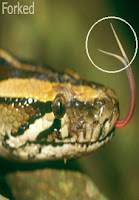 |
| Forked |
<ADJ> Forked / fɔːrkt / (ফোর্ক্ট্) adj [with one end divided into two parts, like the shape of the letter ‘Y’] (শাখান্বিত; দ্বিধাবিভাক্ত): the forked tongue of a snake
Ø Flick / flɪk / (ফ্লিক্) v {Pt. Pp. flicked / flɪkt / (ফ্লিক্ট্)} [to move or make Sth move with sudden quick movements] (টুসকি/ ঝাঁকি মারা): The snake’s tongue flicked out.
Ø Sensitive / ˈsensətɪv / (ˈছেনছএটিভ্) adj [easily influenced, changed or damaged, especially by physical activity or effect] (সংবেদনশীল; স্পর্শকাতর; অভিমানী): The tongue of the snakes are acutely sensitive to vibrate.
<ANT> Insensitive
Ø Vibrate / ˈvaɪbreɪt / (ˈভাইব্রেইট্) v {Pt. Pp. vibrated / ˈvaɪbreɪtɪd / (ˈভাইব্রেইটিড্)} [to shake slightly and quickly, or to cause something to do this, in a way that is felt rather than seen or heard] (কম্পিত/ স্পন্দিত/ স্ফুরিত হওয়া বা করা): The whole station seemed to vibrate as the express train rushed through.
Vibration / vaɪˈbreɪʃn / (ˈভাইব্রেইশন্) n [continuous quick, slight shading movement] (স্পন্দন, কম্পন, স্ফুরণ): Vibrations were felt hundreds of miles from the center of the earthquake.
Ø Hiss / hɪs / (হিছ্) v {Pt. Pp. hissed / hɪst / (হিছ্ট্)} [to make a sound like a long‘s’] (হিস হিস শব্দ করা): The snake lifted its head and hissed.
<NOUN> Hiss [a sound like a long‘s’; this sound used to show disapproval of Sb] (হিস হিস শব্দ): the snake’s hiss
Ø Humid / ˈhjuːmɪd / (ˈহিঊমিড) adj [(of the air or climate) warm and damp] (<বিশেষত বাতাস ও জলবায় সম্বন্ধে> আর্দ্র; সেঁতসেঁতে বা জলো): A hot and humid climate
Ø Literally / ˈlɪtərəli / (ˈলিটএরএলি) adv [simply or just] (আক্ষরিক অর্থে): Then you literally cut the sausage down the middle.
Ø Grow / groʊ / (গৌ) v {Pt. Grew (গ্রূ); Pp. Grown (গ্রৌন্)} [to become bigger or tatter and develop into an adult] (<ব্যক্তি বা প্রাণী সম্বন্ধে> প্রাপ্ত বয়ষ্ক হওয়া; পরিপক্ক হওয়া; সাবালক হওয়া): A growing child needs plenty of sleep.
Ø Out of (pre) [used to show the reason why Sth is done] (হইতে; থেকে): I asked out of curiosity. He did it out of spite.
Ø Rub / rʌb / (রাব) v {Pt. Pp. rubbed / rʌbd / (রাবড্)} [to move a hand, or Sth backward and forwards over a surface while pressing firmly] (ঘসা): He rubbed his chin thoughtfully.
Ø Slither / ˈslɪðər / (ˈস্লিদএর) v {Pt. Pp. slithered / ˈslɪðərd / (ˈস্লিদএর্ড্)} {+ adv. /prep.} [to move somewhere in a smooth, controlled way, often close to the ground] (হড়কাতে হড়কাতে চলা): The snake slithered away as we approached. He watched the snake slither away.
Ø Sock / sɑːk / (ছাঃক) n [a piece of clothing made from soft material that is worn over the foot, ankle and lower part of the leg, especially inside a shoe] (মোজা): A pair of socks
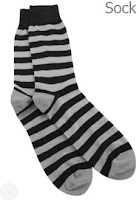 |
| Sock |
Ø <PHR-v> Come off [to be able to removed] (খসা; উঠা; বিচ্ছিন্ন হওয়া): Does this hood come off? That mark won’t come off.
Ø <IDM> Inside out [with the part that is usually inside facing out] (ভিতরের দিক বাইরে; উল্টা করে): You have put on your shirt inside out. Turn the bag inside out and let it dry.
Ø Prey / preɪ / (প্রেই) n [an animal that is hunted and killed by another animal for food] (শিকার): a cat pouncing on its prey
Ø Evolve / iˈvɑːlv / (ইˈভাঃল্ভ্) v [(in biology) (of plants, animals, etc.) to develop over time, often many generations, into forms that are better adapted to survive changes in their environment] (বিবর্ধিত হওয়া; বিকশিত হওয়া/ করা): The three species evolved from a single ancestor.
Ø Aquatic / əˈkwætɪk / (এˈকোঅ্যাটিক্) adj [growing or living in, on or near water] (জলজ <উদ্ভিদ, প্রাণী বিষয়ক>): aquatic plants/ecosystem
Ø Perhaps / pərˈhæps / (পএরˈহ্যাপছ্) adv [possibly] (হয়তো; সম্ভবত): Perhaps he has forgotten.
<SYN> Maybe
Ø Deadly / ˈdedli / (ˈডেডলি) adj {SYN lethal} [causing or likely to cause death] (মারাত্নক; প্রাণঘাতী; সংঘাতিক): The Cobra is one of the world’s deadliest snakes.
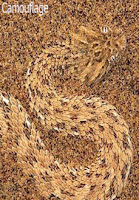 |
| Camouflage |
Ø Camouflage / ˈkæməflɑːʒ / (ˈক্যামএফ্লাঃশ্) n [the way in which an animal’s color or shape matches with its natural environment to prevent it from being seen by attackers] (ছদ্মবেশের দ্বারা ফাঁকি; মিথ্যা প্রতিভাস; কূটাবরণ): The lizard’s light brown skin acts as (a) camouflage in the desert sand.
Ø Dusty / ˈdʌsti / (ˈডাছটি) adj [(of color) not bright; dull] (<রং সম্পর্কে> ধূলিমলিন): dusty pink
Ø Frighten / ˈfraɪtn / (ˈফ্রাইটন্) v {Pt. Pp. frightened / fraɪtnd / (ˈফ্রাইটন্ড্)} [to make Sb suddenly feel afraid] (ভীত/ আতঙ্কিত করা; ভয় পাইয়ে দেওয়া): You will frighten the babywearing that mask.
<SYN> Scare
<ADJ> Frightened / fraɪtnd / (ফ্রাইটন্ড্) adj [afraid; feeling fear or worry] (ভীত; শঙ্কিত; সন্ত্রস্ত): The cop found a frightened baby in the hut. Do not be frightened? What are you frightened of?
Ø Tend / tend / (টেন্ড্) v {Pt. Pp. tended / tendɪd / (টেন্ডিড্)} [to be likely to behave in a particular way or have a particular characteristic] (কোনো বিশেষ দিকে ঝোঁকা; প্রবণতা দেখানো): He tends to be whimsical in taking decisions.
<NOUN> Tendency / ˈtendənsi / (ˈটেনডএনছি) n [if someone has a tendency to do or like something, they will probably do it or like it] (প্রবণাতা; ঝোঁকা): I have a tendency to talk too much when I am nervous.
Ø Flee / fliː / (ফ্লী) v {Pt. Pp. fled (ফ্লেড্)} [to leave a person or place very quickly, especially because you are afraid of possible danger] (পালানো; ভাগা): He was caught trying to flee the country.
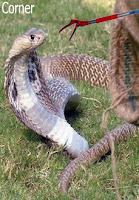 |
| Corner |
Ø Corner / ˈkɔːrnər / (ˈকোর্নএর) v {Pt. Pp. cornered / ˈkɔːrnərd / (ˈকোর্নএরড্)} [to force a person or an animal into a place or situation from which they cannot easily escape] (কোনঠাসা করা; মুশকিলে ফেলা): If cornered, the snake will defend itself.
Ø Antagonize / ænˈtægənaɪz / (এ্যানˈট্যাগএনাইজ) v [to do Sth to make Sb angry with you] (শত্রুভাবাপন্ন করা; দ্বন্দ্বে বা সংঘাতে ঠেলে দেওয়া): I did not want to antagonize him.
Ø Venom / ˈvenəm / (ˈভেনএম) n [the poisonous liquid which some snakes, insects or spiders produce when they bite or sting] (সর্পবিষ; গরল):
<ADJ> Venomous / ˈvenəməs / (ˈভেনএমএছ্) adj [(of a snake) producing venom] (বিষধর; বিষাক্ত): a venomous snake
 |
| Fang |
Ø Fang / fæŋ / (ফ্যাঙ্) n [either of two long sharp teeth at the front of the mouths of some animals, such as a snake or dog] (সাপের বিষদাঁত; কুকুর ও নেকড়ের লম্বা ছুঁচালো দাঁত):
Ø Penetrate / ˈpenətreɪt / (ˈপেনএট্রেইট) v {Pt. Pp. penetrated / ˈpenətreɪtɪd / (ˈপেনএট্রেইটিড্)} [to go into or through Sth] (কোনোকিছুর মধ্যে ঢুকানো; বিদ্ধ করা ব ভেদ করা): These fine particles penetrate deep into the lungs.
Ø Groove / gruːv / (গ্রুভ্) n [a long narrow hollow space cut into a surface] (খাঁজ): The window slides along a deep metal groove to open and close.
Ø Inject / ɪnˈdʒekt / (ইন্ˈজেক্ট্) v {injects; Pt. Pp. injected} [to put a drug or other liquid into a person's or animal's body using a syringe] (সূচ ফুটানো): The fruits are injected with chemicals to reduce decay.
Ø Poison / ˈpɔɪzən / n (ˈপোইযএন্) [a substance that can make people or animals ill or kill them if they eat or drink it] (বিষ; গরল): He killed himself with poison
<ADJ> Poisonous / ˈpɔɪzənəs / (ˈপোইযএনএছ্) n {SYN venomous} [(of animals and insects) producing a poison that can cause death or illness if the animal or insect bites you] (বিষাক্ত; বিষধর): a poisonous snake
Ø Toxin / ˈtɑːksɪn / (ˈটাঃকছিন্) n [a poisonous substance, especially one which is produced by bacteria in plants and animals and which causes disease] (ব্যাকটেরিয়া থেকে জন্মানো বিশেষ ধরনের বিষাক্ত পদার্থ; উপবিষ):
Ø Worship / ˈwɜːrʃɪp / (ˈওয়ারশিপ্) n [the practice of showing respect for God or a god, by saying prayers, singing with others, etc.; a ceremony for this] (পূজা; উপাসনা; অর্চনা; ভক্তি): In the various regions of India, Hindus worship different gods and observe different religious festivals.
Ø Devil / ˈdevl / (ˈডেভল) n {SYN satan} [the Devil (a powerful evil force) and the enemy of God in the Jewish, Christian, and Muslim religions] (শয়তান; আপদ; অপদেবতা; নরাধম): He would sell his soul to the Devil.
Ø Serve / sɜːrv / (ছা্র্ভ্) v {Pt. Pp. served / sɜːrvd / (ছা্র্ভ্ড্)} [to be useful to Sb in achieving or satisfying Sth] (সেবা করা; প্রোজন মেটানো/কাজ করা): These experiments serve no useful purpose.
Ø Regard / rɪˈgɑːrd / (রিˈগাঃর্ড্) v {regard Sb/Sth as} [to think about Sb/Sth in a particular way] (বিবেচনা করা/গ্ণ্য করা): He regards himself as a patriot.
Ø Pest / pest / (পেছ্ট্) n [an insect or small animal that is harmful or that damages plants, food, and other crops] (ধবংসান্তক বা ক্ষতিকারক প্রাণী/ কীটপতঙ্গ): common pests such as rats, cockroaches, mosquito, etc.
<NOUN> Pesticide / ˈpestɪsaɪd / (ˈপেছটিছাইড) n {SYN insecticide} [a chemical used for killing pests, especially insects] (কীটনাশক): Vegetables are grown without the use of pesticides. The pesticides that farmers spray on their crops kill pests but they can also damage people’s health.
Ø Spit / spɪt / (স্পিট্) v {Pt. Pp. spat (স্প্যাট)} [(of animals) to make a short angry sound] (<প্রাণী সম্নন্ধে> রাগতস্বর সৃষ্টি করা): Snakes spit and hiss when they are cornered.
Ø Coil / kɔːl / (কয়ল) v {Pt. Pp. coiled / kɔːld / (কয়লড্)} [a length of rope, hair, or wire, arranged into a series of circles, one above the other] (কুণ্ডলী করা বা হওয়া): The python coiled itself tightly around the deer.
Ø Witchcraft /ˈwɪtʃkræft / (ˈউইচক্র্যাফট) n [the activity of performing magic powers, especially to help or harm other people] (ঝাড়ফুঁক; তাবিজকবোজ): He was accused of witchcraft.
Anaconda
Anaconda / ˌænəˈkɑːndə / (এ্যানএˈকআঃন্ডএ) n [a large South American semiaquatic snake of the boa family that curls around a live animal and crushes it to kill it for food, which may grow to a great size] (<পৃথিবীতে সবচে বড় সাপ>অ্যানাকান্ডা):
Ø Semiaquatic / ˌsemiəˈkwætɪk / (ˌছেমিএˈকোয়াটিক্) n [(of an animal) living partly on land and partly in water] (অর্ধ জলজ):
Ø Curl / kɜːrl / (কা্র্ল্) v {Pt. Pp. curled} [to form or cause to form into a curved or spiral shape] (পেঁচান বা কোঁকড়া করা): She used to curl her hair with rags.
Ø Crush / krʌʃ / (ক্রাশ্) v {crushes / krʌʃɪz / (ক্রাশিয্); Pt. Pp. crushed / krʌʃt / (ক্রাশট্)} [to press or push something very hard into a small space so that it is broken] (চূর্ণ করা): Several people were crushed to death in the accident.
Barbados Thread Snake
Barbados thread snake / bɑːrˈbeɪdoʊs θred sneɪk / (বআঃর্বেইডৌছ্ থ্রেডস্নেইক্) n [a species of thread snake. It is the smallest known snake species is found on the Caribbean island of Barbados. The average length of adults is approximately 10 cm, (3.94 inches)] (<পৃথিবীতে সবচে ছোট সাপ> বার্বেইডৌস সুতা সাপ):
Ø Thread / θred / (থ্রেড্) n [a long, thin strand of cotton, nylon, or other fibers used in sewing or weaving] (সুতা; সূত্র): needle and thread
Ø Approximately / əˈprɑːksəmətli / (এˈপ্রআঃক্সএমএটলি) n [used to show that something is almost, but not completely, accurate or exact; roughly] (প্রায়; কাছাকাছি): The journey took approximately seven hours.
Boa Constrictor
Boa constrictor / ˈboʊə kənˌstrɪktər / (ˈবৌএ কএন্ˌস্ট্রিক্টএর্) n {Also boa} [a large, strong snake, found in South and Central America, that kills animals and birds by wrapping itself around them and crushing them to death] (বৌএ কান্স্ট্রিক্টার সাপ):
Ø Wrap / ræp / (র্যাপ্) v {wraps; Pt. Pp. wrapped / ræpt / (র্যাপ্ট্)} [to put Sth firmly around Sth/Sb] (জড়ান; মোড়া): His arms were wrapped around her waist.
Python
Python / ˈpaɪθɑːn / (ˈপাইথআঃন্) n [a very large snake that kills preys for food by wrapping itself around them and constriction and suffocates them] (অজগর):
Ø Constrict / kənˈstrɪkt / (কএনˈস্ট্রিক্ট্) n {constricts; Pt. Pp. constricted} [to become tighter and narrower, especially by encircling pressure] (সংকুচিত করা): a drug that constricts the blood vessels.
<NOUN> Constriction / kənˈstrɪkʃən / (কএন্ˈস্ট্রিকশএন্) n [the action of making something narrower by pressure or of becoming narrower; tightening] (সংকোচন): He felt a constriction (= a tight feeling) in his chest.
Ø Suffocate / ˈsʌfəkeɪt / (ˈছাফএকেইট্) n {suffocates; Pt. Pp. suffocated} [to die because there is no air to breathe; to kill Sb by not letting them breathe air] (শ্বাসরোধ করা বা হওয়া): He suffocated him by holding a pillow over her face.
Ball Python
Ball python / bɑːl ˈpaɪθɑːn / (বআঃল্ ˈপাইথআঃন্) n [also known as the royal python, which curls into a tight ball with the head hidden when alarmed, is a python species found in sub-Saharan Africa. Like all other pythons, it is a nonvenomous constrictor. This is the smallest of the African pythons and is popular in the pet trade, largely due to its small size] (বল পাইথন; রাজকীয় অজগর):
Ø Royal / ˈrɔɪəl / (ˈরোইএল্) n [of quality or size suitable for a king or queen; splendid] (রাজকীয়): The team was given a royal reception/welcome.
Ø Alarm / əˈlɑːrm / (এˈলআঃর্ম্) v {alarms / əˈlɑːrmz / (এˈলআঃর্ময্); Pt. Pp. alarmed} [to make someone worried or frightened] (আতঙ্ক): It alarms me that nobody takes this problem seriously.
<SYN> Worry
Ø Nonvenomous / ˌnɑːnˈvenəməs / (ˌনআঃন্ˈভেনএমএস্) v [not producing venom] (বিষহীন):
Viper
Viper / ˈvaɪpər / (ˈভাইপএর্) n [a venomous snake with large hinged fangs, typically having a broad head and plump body, with dark patterns on a lighter background, found in most parts of the world, they are also known as viperids] (নাগ সাপ):
Ø Hinged / hɪndʒd / (হিন্জড্) v [attached or joined with a hinge] (কব্জার ন্যায় আটকানো): a hinged lid
Ø Plump / plʌmp / (প্লাম্প) v [having a pleasantly soft, rounded body or shape] (মাংসল; নাদুসনুদুস): a nice plump chicken
Ø Dark / dɑːrk / (ডআঃর্ক্) v [(of a color) nearer to black than white in color] (কাল): dark blue/green
Ø Pattern / ˈpætərn / (ˈপ্যাটএর্ন্) v [a regular arrangement of lines, shapes, colors, etc. as a design on material, carpets, etc.] (কারুকাজ): a shirt with a herringbone pattern
Pit Viper
Pit viper / pɪt ˈvaɪpər / (পিট্ ˈভাইপএর্) n [a venomous snake of a group distinguished by visible sensory pits organ located between the eye and the nostril on both sides of the head which can detect prey by heat. They are found in both America and Asia] (পিট নাগ):
Ø Visible / ˈvɪzəbəl / (ˈভিযএবএল্) v [able to be seen] (দৃশ্যমান; সাক্ষাৎ): The writing on the tombstone was barely visible.
Ø Sensory / ˈsensəri / (ˈছেন্ছএরি) v [connected with the physical senses of touch, smell, taste, hearing, and sight] (সংজ্ঞাবহ; সংবেদন বা ইন্দ্রিয় সংক্রান্ত): sensory organs
Ø Pit / pɪt / (পিট্) n [a large hole in the ground, or a slightly low area in any surface] (গর্ত): These pits in my skin are from when I had chickenpox.
King Snake
King snake / ˈkɪŋ sneɪk / (ˈকিঙ্স্নেইক্) n [a large, smooth-scaled North American constrictor which typically has shiny dark brown or black skin with lighter markings] (রাজা সাপ):
Queen Snake
Queen snake / kwiːn sneɪk / (কূঈন্ স্নেইক) n [a harmless aquatic colubrid snake of central and eastern North America, which has a mainly brown body with a yellowish stripe along each side] (রানী সাপ):
Ø Stripe / straɪp / (স্ট্রাইপ্) adj [a long, narrow line of color or texture, which is a different color from the areas next to it] (ডোরা): The zebra is a wild African horse with black and white stripes.
Milk Snake
Milk snake / mɪlk sneɪk / (মিল্ক স্নেইক্) n [a harmless North American snake that is strongly marked with red and black on yellow or white. It was formerly supposed to suck milk from sleeping cows] (দুধ সাপ):
Ø Harmless / ˈhɑːrmləs / (ˈহআঃর্ম্লএছ্) adj [not able or not likely to cause harm] (নিরীহ): Most bacteria are harmless to humans.
Ø Formerly / ˈfɔːrmərli / (ˈফোর্মএর্লি) adv {SYN previously} [in the past; in earlier times] (পূর্বে): ‘Mumbai, formerly Bombay’
Ø Suck / sʌk / (ছাক্) v [to take liquid, air, etc. into your mouth by using the muscles of your lips] (চোষা): They suck mint juleps through straws.
Mamba
Mamba / ˈmæmbə / (ˈম্যাম্বএ) n [a large, agile, highly venomous snake that lives mainly in caves or trees in parts of Africa] (আফ্রিকার বিষধর গেছো সাপ):
Ø Agile / ˈædʒaɪl / (ˈএ্যাজাইল্) adj [able to move your body quickly and easily] (ক্ষিপ্র): Monkeys are very agile climbers.
Ø Cave / keɪv / (কেইভ্) n [a large hole in a hillside, cliff, or mountain, or one that is underground] (গুহা): The echoes of his scream sounded in the cave for several seconds.
Black Mamba
Black mamba / blæk ˈmæmbə / (ব্ল্যাক্ ˈম্যাম্বএ) n [an extremely venomous slender olive-brown to a dark grey snake that moves with great speed and agility. Native to eastern and southern Africa, it is the largest poisonous snake on the continent] (কালো ম্যাম্বা):
Ø Slender / ˈslendər / (ˈস্লেন্ডএর্) adj {SYN slim} [(of people or their bodies) thin in an attractive or elegant way] (সরু): a slender young woman
Garter Snake
Garter snake / ˈɡɑːrtər ˌsneɪk / (ˈগআঃর্টএর ˌস্নেইক্) n [a small to medium-sized harmless North American snake that typically has well-defined longitudinal stripes along its body and favors damp habitats] (গাটার সাপ):
Ø Well defined / ˌwel dɪˈfaɪnd / (ˌওএল্ ডিˈফাইন্ড্) adj [clearly expressed, explained, or described] (ভাল সংজ্ঞায়িত): These categories are not well defined.
Ø Longitudinal / ˌlɑːndʒəˈtʃuːdnl / (ˌলআঃন্জএˈচূডনল্) adj [running lengthwise rather than across] (অনুদৈঘ্র্য): longitudinal stripes
Ø Damp / dæmp / (ড্যাম্প্) adj [slightly wet, especially in a way that is not pleasant or comfortable] (স্যাঁতসেঁতে; আর্দ্র): damp clothes
Ø Habitat / ˈhæbɪtæt / (ˈহ্যাবিট্যাট্) n [the natural environment or home in which an animal or plant usually lives] (জীবজন্তু বা গাছ পালার স্বাভাবিক আবাস): wildlife is losing its natural habitat.
Cottonmouth
Cottonmouth / ˈkɑːtnmaʊθ / (ˈকআঃটন্মাউথ্) n [a large, dangerous semiaquatic pit viper that inhabits lowland swamps and waterways of the southeastern United States. When threatened, they may respond by coiling their bodies and displaying their fangs] (কাটনমাউথ সাপ):
Ø Danger / ˈdeɪndʒər / (ˈডেইনজএর্) n [the possibility of Sth happening that will injure, harm or kill Sb, or damage or destroy Sth] (বিপদ; ঝুঁকি): Danger! Keep out!
<ADJ> Dangerous / ˈdeɪndʒərəs / (ˈডেইন্জএরএছ্) adj [able or likely to cause harm or injury Sb] (বিপজ্জনক): a dangerous animal
Ø Swamp / swɑːmp / (ছোয়াম্প্) n {SYN marsh} [(an area of) very wet, soft land in which plants, trees, etc. are growing] (জলা; জলাভূমি): a cottonmouth-infested swamp
Ø Waterway / ˈwɔːtəweɪ / (ˈওয়াটএরওয়েই) n [a narrow area of water, such as a river or canal, which ships or boats can sail along] (জলপথ): a navigable waterway
Checkered Keelback /ˈtʃekərd kiːlbæk / (ˈচেকএর্ড্ কীলব্যাক্) n {Also Asiatic water snake} [also known as commonly the Asiatic water snake, is a common species, the
species is endemic to Asia. It is non-venomous] (ঢোঁড়া বা জলঢোঁড়া সাপ):
Rat Snake
Rat snake / ræt sneɪk / (র্যাট স্নেইক্) n [a harmless constricting snake that feeds on rats and other small mammals] (দাঁড়াশ সাপ):
Ø Constrict / kənˈstrɪkt / (কএন্ˈস্ট্রিক্ট্) n [to become tighter and narrower, especially by encircling pressure] (সংকুচিত করা): The drug causes the blood vessels to constrict.
Ø <PHR-V> Feed on/off Sth [(of an animal) to eat Sth] (<প্রাণী সম্বন্ধে>কোনোকিছু খাওয়া): Butterflies feed on the flowers of garden plants.
Grass Snake
Grass snake / ɡræs sneɪk / (গ্র্যাছ্ স্নেইক্) n [a common harmless Eurasian non-venomous snake that typically has a yellowish band around the neck and It is often found near water and feeds almost exclusively on amphibians] (ঘেসো সাপ):
Ø Band / bænd / (ব্যান্ড্) n [a stripe or line of a different color or texture on Sth that is different from what is around it] (পটি): a long, narrow band of cloud
Ø Exclusively / ɪkˈskluːsɪvli / (ইকˈছক্লূছিভ্লি) adv [to the exclusion of others; only] (কেবলমাত্র; শুধুমাত্র): an exclusively female audience
Trinket Snake
Trinket Snake / ˈtrɪŋkɪt sneɪk / (ˈট্রিঙ্কিট্ স্নেইক্) n [the common trinket snake is a nonvenomous snake
native to south Central Asia] (সুন্দরী সাপ):Trinket / ˈtrɪŋkɪt / (ˈট্রিঙ্কিট্) n [a small decorative object, or a piece of jewelry
that is cheap or not worth much money] (তুচ্ছ বা কমদামি গহনা):
King Cobra
King cobra / kɪŋ ˈkoʊbrə / (কিঙ্ ˈকৌব্রএ) n [The king cobra is the world's longest venomous snake, with an average length of 3.18 to 4 m reaching a maximum of 5.85 m (19.2 ft). Its skin color varies across the habitats, from black with white stripes to unbroken brownish grey. It preys chiefly on other snakes, including its own species. Unlike other snakes, it rarely hunts other vertebrates, such as rodents and lizards. a species of venomous elapid snake endemic to jungles in Southern and Southeast Asia.] (শঙ্খচূড়, পদ্ম গোখরা, রাজ গোখরা):
Ø Patch / pætʃ / (প্যাচ্) n [a small area that is different in some way from the area that surrounds it] (দাগ; তালি): Our cat has a black patch on her back.
Indian Cobra
Indian cobra / ˈɪndiən ˈkoʊbrə / (ˈইনডিএন্ ˈকৌব্রএ) n [also known as the spectacled cobra, or Asian cobra with a marking on the hood that resembles spectacles. The Indian cobra is idolized in Indian mythology and culture, and is often seen with snake charmers] (ভারতীয় গোখরা; খড়মপায়া বা খইয়া (খৈয়া) গোখরা):
Ø Resemble / rɪˈzembəl / (রিˈযেম্বএল্) v [to look like or be like someone or something] (অনুরূপ হওয়া; মিল হওয়া/থাকা): The plant resembles grass in appearance.
Ø Spectacles / ˈspektəkəlz / (ˈস্পেক্টএকএলয্) n [a pair of glasses] (চশমা): gold-rimmed spectacles
Ø Idolize / ˈaɪdəlaɪz / (ˈআইডএলাইয্) v {SYN worship} [to admire and respect Sb very much, often too much] (শ্রদ্ধা করা; ভক্তি করা): He idolized his mother.
 |
| Snake Charmer |
Ø Mythology / mɪˈθɑːlədʒi / (মিˈথআঃলএজি) n [a popular belief that is probably not true] (পুরাণ; পুরাণশাস্ত্র; শ্রুতি): the popular mythology that life begins at forty
Ø Snake charmer / ˈsneɪk ˌtʃɑːrmər / (ˈস্নেইক্ ˌচআঃর্মএর্) n [an entertainer who appears to make snakes move by playing music] (সাপুড়ে; বেদে):
Egyptian Cobra
Egyptian cobra / iˈdʒɪpʃən ˈkoʊbrə / (ইˈজিপ্শএন্ ˈকৌব্রএ) n [a large nocturnal African cobra with a thick body and large head is one of the largest cobra species] (মিশরীয় গোখরা):
Ø Nocturnal / nɑːkˈtɜːrnəl / (নআঃক্ˈটা্র্নএল্) adj [(of animals) active at night] (নিশাচর; নৈশ): most owls are nocturnal
Philippine Cobra
Philippine cobra / ˈfɪlɪpiːn ˈkoʊbrə / (ˈপিলিপীন্ ˈকৌব্রএ) n {Also called northern Philippine cobra} [a stocky, highly venomous species of spitting cobra with long cervical ribs capable of expanding, so when threatened, a hood can be formed, native to the northern regions of the Philippines] (ফিলিপিনিয়ান গোখরা):
Ø Stocky / ˈstɑːki / (ˈস্টআঃকি) adj [broad and sturdily built] (গাঁট্টাগোট্টা):
Ø Spit / spɪt / (স্পিট্) v {spits / spɪts / (স্পিট্ছ্); Pt. Pp. spat / spæt / (স্প্যাট্)} [to force out the contents of the mouth, especially saliva] (পিক করে থুথু ফেলা বা দেওয়া): He spat the meat out in disgust.
Ø Cervical / səˈrvaɪkəl / (ছএˈর্ভাইকএল্) n [relating to the neck] (ঘাড়সংক্রান্ত): the cervical spine
Ø Rib / rɪb / (রিব্) n [any of the curved bones that are connected to the spine and surround the chest] (পাঁজর): I woke him up with a poke in the ribs.
Ø Expand / ɪkˈspænd / (ইকˈস্প্যান্ড্) v [to increase in size, number, or to make something increase in this way] (প্রসারিত করা/হওয়া): The air in the balloon expands when heated.
Banded Krait
Banded krait / bændɪd kraɪt / (ব্যান্ডিড্
ক্রাইট্) n [a
species of elapid snake found on the Indian Subcontinent, it’s easily
identified by its alternate black and yellow cross bands, its triangular body
cross-section, and the marked vertebral ridge consisting of enlarged vertebral
shields along its body. The head is broad and depressed. The eyes are black. It
has arrowhead-like yellow markings on its otherwise blackhead and has yellow
lips, chin, and throat] (শঙ্খিনী বা ভোতালেজ কেউটে বা ডোরা কাল কেউটে বা ডোরা শঙ্খিনী):
Common Krait
Common krait / ˈkɑːmən kraɪt / (ˈকআঃমএন্ ক্রাইট্) n {Also known as Indian krait or blue krait} [a species of venomous snake found in the jungles of the Indian subcontinent. It is a member of the "big four" species, inflicting the most snakebites on humans in India] (শাঁখামুঠি বা পাতি কাল কেউটে):
Ø Inflict / ɪnˈflɪkt / (ইনˈফ্লিক্ট্) v {inflicts / ɪnˈflɪkts /; Pt. Pp. inflicted / ɪnˈflɪktɪd / (ইনফ্লিক্ট্টিড্)} [to force someone to experience something very unpleasant] (হানা; প্রদান করা): The rodent's sharp teeth can inflict a nasty bite.
Ø Snakebite / ˈsneɪkbaɪt / (ˈস্নেইক্বাইট্) n [a wound that you get when a poisonous snake bites you] (সাপের কামড়; সর্পদংশন): Four people have recently died from snakebites.
Russell's Viper
Russell's viper / rʌsəlz ˈvaɪpər / (রাছএলয্ ˈভাইপএর্) n {Also chain viper} [a large venomous Asian snake which has a yellow-brown body with black markings] (চন্দ্রবোড়া):
Saw-scaled Viper
Saw-scaled viper / sɑː-skeɪld ˈvaɪpər / (ছআঃ-স্কেইল্ড্ ˈভাইপএর্) n {Also little Indian viper} [a venomous viper species found in parts of the Middle East and Central Asia, and especially the Indian subcontinent] (ফুরসা বোড়া সাপ; খুঁদে চন্দ্রবোড়া):
Ø Saw / sɔː / (ছো) n [a tool for cutting wood or other hard materials, with a long, thin serrated blade and operated using a backward and forwards movement] (করাত): a hand/power saw
Corn Snake
Corn snake / kɔːrn sneɪk / (কোর্ন্ স্নেইক্) n [a long North American species of rat snake with a spear-shaped mark between the eyes. that subdues its small prey by constriction. its lack of functional venom and help control populations of wild rodent pests that damage crops and spread disease] (শস্য সাপ):
Ø Corn / kɔːrn / (কোর্ন্) n [(the seeds of) plants, such as wheat, maize, oats, and barley, which can be used to produce flour] (শস্যকণা): a sheaf/ears of corn
Ø Spear / spɪər / (স্পিএর্) n [a weapon with a long wooden handle and a sharp metal pointed the tip at one end, used for throwing, hunting and fishing] (বর্শা; বল্লম): She had a fish impaled on the point of her spear.
Spear-shaped (বর্শা-আকৃতির):
Ø Subdue / səbˈduː / (ছএবˈডূ) v {SYN defeat} [to bring Sb/Sth under control, especially by using force] (কাবু করা; বশে আনা): The fire burned for ten hours before the firefighters could subdue it.
Ø Lack / læk / (ল্যাক্) n {usually lack of Sth} [the state of not having Sth or not having enough of Sth] (অভাব; ঘাটতি): There was no lack of volunteers.
Ø Population / ˌpɑːpjəˈleɪʃən/ (ˌপআঃপুলেইশএˈন্) n [a community of animals, plants, or humans, who live in one country, area, or place] (অধিবাসিগণ; সংখ্যা): The dolphin population has been decimated by tuna fishing.
Ø Rodent / ˈroʊdənt / (ˈরৌডএন্ট্) n [any small mammals with strong sharp front teeth, such as rats, mice, rabbits etc.] (ইঁদুরের ন্যায় তীক্ষ্ণদন্ত প্রাণী):
Black Rat Snake
Black rat snake / ˈblæk ræt sneɪk / (ˈব্ল্যাক্ র্যাট্ স্নেইক্) n [a large, non-venomous snake, found in eastern North America, with chiefly blackish coloration (also called pilot black-snake, black snake)] (কালো সাপ):
Ø Chiefly / ˈtʃiːfli / (ˈচীফ্লি) adv {SYN primarily, mainly} [not completely, but as a most important part] (প্রধানত; বিশেষত): She is traveled widely, chiefly in Africa and Asia.
Ø Coloration / ˌkʌləˈreɪʃən / (ˌকালএˈরেইশএন্) n [the natural colors and patterns on a plant or an animal] (রঙকরণ): Many insects have bright coloration, which has evolved as a protection against predators.
Rattlesnake
Rattlesnake / ˈrætəlsneɪk / (ˈর্যাটএলস্নেইক্) n [a heavy-bodied poisonous pit viper with a series of horny rings on the tail that produce a loud rattling sound when vibrated as a warning, found in southern parts of the US] (ঠকঠকি সাপ; র্যাটল সাপ):
Ø Rattle / ˈrætl / (ˈর্যাটল্) v [to make a series of short loud sounds when hitting against Sth; to make Sth do this] (খড়খড় শব্দ করা): The explosion rattled the cups on the table.
Ø Horny / ˈhɔːrni / (ˈহোর্নি) adj [made of a hard substance like horn] (): the bird's horny bill
Ø Vibrate / ˈvaɪbreɪt / (ˈভাইব্রেইট্) v [to move or make Sth move from side to side very quickly and with small movements] (কম্পিত হওয়া): His voice vibrated with anger.
Taipan
Taipan / ˈtaɪpæn / (ˈটাইপ্যান্) n [a large brown, fast-moving, highly venomous Australian snake. they are considered some of the most deadly known snakes] (টাইপ্যান সাপ):
Inland Taipan
Inland taipan / ˈɪnlænd ˈtaɪpæn / (ˈইন্ল্যান্ড্ ˈটাইপ্যান্) n {Also called western taipan, the small-scaled snake, or the fierce snake} [a large brown highly venomous Australian snake with a dark tan, ranging from a rich, dark hue to a brownish light-green, depending on the season. It is back, sides, and tail may be different shades of brown and grey, with many scales having a wide blackish edge] (ইনল্যান্ড টাইপ্যান সাপ):
Ø Tan / tæn / (ট্যান্) v [the brown color that Sb with pale skin goes when they have been in the sun] (তামাটে রঙ): My tan's fading already.
Massasauga
Massasauga / ˌmæsəˈsɔːɡə / (ˌম্যাছএˈছোগএ) n [a small Midwestern North American rattlesnake of variable color which favors damp habitats] (ম্যাসাসোগা সাপ):
Sea Snake
Sea snake / siː sneɪk / (ছী স্নেইক্) n {Also coral reef snake} [a venomous marine snake with a flattened tail, which lives in the warm coastal waters of the Indian and Pacific oceans and does not come on to land] (সামুদ্রীক সাপ):
Hognose Snake
Hognose snake / ˈhɔːɡnoʊz sneɪk / (ˈহোগ্নোয্ স্নেইক্) n {Also hog-nosed snake} [a harmless burrowing American snake with an upturned nose. When threatened it inflates itself with air and hisses and may feign death] (হগনোজ সাপ):
Ø Burrowing / ˈbɜːroʊɪŋ / (ˈবা্রৌইঙ্) adj [denoting an animal that makes holes or tunnels, typically for use as a dwelling] (গর্ত বাসি প্রাণী): rodents and other burrowing animals
Ø Upturned / ˌʌpˈtɜːrnd / (ˌআপˈটা্র্ন্ড্) adj [pointing or facing upwards] (ঊর্ধ্বোত্থিত): an upturned nose
Ø Inflate / ɪnˈfleɪt / (ইন্ˈফ্লেইট্) v [to fill Sth or become filled with gas or air] (ফোলানো): She inflated the balloons with helium.
Ø Feign / feɪn / (ফেইন্) v [to pretend to have a particular feeling, problem, etc.] (ভান করা): He feigned sleep to avoid having to answer.
Green Snake
Green snake / ɡriːn sneɪk / (গ্রীন্ স্নেইক্) n [a harmless North American snake with a green back and white or yellowish underparts] (সবুজ সাপ):
Boomslang
Boomslang / ˈbuːmslæŋ / (ˈবূম্স্ল্যাঙ্) n {Also little Indian viper} [a large, highly venomous southern African tree snake, their eyes are exceptionally large, and the head has a characteristic egg-like shape. the male of which is bright green and the female dull olive brown] (বূমস্ল্যাং সাপ):
Sidewinder
Sidewinder / ˈsaɪdwaɪndər / (ˈছাইড্ওয়াইন্ডএর্) n {Also horned rattlesnake and sidewinder rattlesnake} [a pale-colored, nocturnal, burrowing rattlesnake that moves sideways over sand by throwing its body into S-shaped curves. It is found in the deserts regions of the southwestern United States and northwestern Mexico] (সাইডওইন্ডার সাপ):
Ø Sideways / ˈsaɪdweɪz / (ˈছাইড্ওএইয্) adv [in a direction to the left or right, not forwards or backward] (পার্শ্বাভিমুখে; পাশের দিকে): The truck skidded sideways across the road.
Brown Snake
Brown snake / braʊn sneɪk / (ব্রাউন্ স্নেইক্) n {Also Australian brown snake} [a fast-moving, aggressive venomous Australian snake, with a variety of color forms, considered to be some of the most dangerous snakes in the world; even young snakes are capable of delivering a fatal envenomation to a human] (বাদামী সাপ):
Ø Aggressive / əˈɡresɪv / (এˈগ্রেছিভ্) adj [angry, and behaving in a threatening way; ready to attack] (আক্রমনাত্মক; মারমুখো): Men tend to be more aggressive than women.
Ø Fatal / ˈfeɪtl / (ˈফেইটল্) adj [causing or ending in death] (মারাত্মক; প্রাণনাশক; সাঙ্ঘাতিক): If he gets ill again it could prove fatal.
Ø Envenomation / inˌvenəˈmeɪʃn / (ইনˌভেনএˈমেইশন) n [the process by which venom is injected by the bite or sting of a venomous animal] ():
Brown Tree Snake
Brown tree snake / braʊn triː sneɪk / (ব্রাউন্ ট্রী স্নেইক্) n [a nocturnal tree snake of Pacific origin that has escaped captivity as a pet to threaten native fauna in many Pacific Rim locations] (বাদামী গেছো সাপ):
Tiger Snake
Tiger snake / ˈtaɪɡər sneɪk / (ˈটাইগএর স্নেইক) n [a highly venomous snake species found in the southern regions of Australia, they are highly variable in their color, often banded like those on a tiger] (শার্দূল সাপ):
Worm Snake
Worm snake / wɜːrm sneɪk / (ওয়ার্ম স্নেইক্) n [a small harmless North American snake which resembles an earthworm] (কীট সাপ):
Ø Worm / wɜːrm / (ওয়ার্ম্) n [any of a number of creeping or burrowing invertebrate animals with long, slender soft bodies and no bones or legs, that live in soil] (কীট; কীড়া): birds looking for worms
Ring-Necked Snake
Ring-necked snake / ˈrɪŋ-nekt sneɪk / (ˈরিঙ-নেক্ট্ স্নেইক্) n {Also ringneck snake} [a harmless species of snake found throughout much of the United States, central Mexico, and southeastern Canada. Ring-necked snakes are secretive, nocturnal snakes, so are rarely seen during the daytime. They are slightly venomous, but their nonaggressive nature and small, rear-facing fangs pose little threat to humans. They are best known for their unique defense posture of curling up their tails, exposing their bright red-orange posterior, and ventral surface when threatened] (আংটি সাপ):
Indigo Snake
Indigo snake / ˈɪndɪɡoʊ sneɪk / (ˈইন্ডিগৌ স্নেইক্) n [a large, harmless, robust snakes which can reach a total length of over 3 m (9.8 ft.). They have smooth dorsal scales, and several color variations, including a glossy blue-black color, found in the Southeastern United States, Central America, and South America] (ইন্ডিগৌ সাপ):
Ø Indigo / ˈɪndɪɡoʊ / (ˈইন্ডিগৌ) adj [very dark blue in color] (ধূম্র নীল): an indigo sky
Ø Robust / roʊˈbʌst / (রৌˈবাস্ট্) adj [(of a person or animal) strong and healthy] (শক্তিশালী ও স্বাস্থ্যাবান): He was almost 92, but still very robust.
Ø Dorsal / ˈdɔːrsl / (ˈডোর্ছল্) adj [on or connected to the upper side or back of an animal, plant] (পৃষ্ঠদেশীয়): a shark's dorsal fin
Ø Glossy / ˈɡlɑːsi / (ˈগ্লআঃছি) adj [shiny and smooth] (মসৃণ ও উজ্জ্বল): a dog with a glossy coat
Death Adder
Death adder / deθ ˈædər / (ডেথ্ ˈএ্যাডএর্) n [a venomous Australian snake with a thin wormlike tail that it uses to lure birds and other prey. They have short, robust bodies, triangular-shaped heads, and small subocular scales. They also have vertical pupils and many small scales on the top of the head] (ডেথ্ অ্যাডার):
Ø Subocular / ˌsʌbˈɒkjʊlər / (ˌছাবˈকুলএর্) v [one of the small scales between the eye and the upper labials of some reptiles] ():
Adder
Adder / ˈædər / (ˈএ্যাডএর্) v [a small venomous snake which has a dark zigzag pattern on its back and bears live young. It is the only poisonous snake in Britain] (বৃটিশ সাপ):
Ø Zigzag / ˈzɪɡzæɡ / (ˈযিগয্যাগ্) v [a line or pattern that looks like a series of letter Z or a row of Zs joined together] (আঁকাবাঁকা সর্পিল; ট্যারাব্যাঁকা): The path rose in zigzags up the hillside.
Ø Bear / beər / (বেএর্) v {bears / beərz / (বেএরয্); Pt. bore / bɔːr / (বোর্); Pp. born / bɔːrn / (বোর্ন্)} [to give birth to young, or (of a tree or plant) to give or produce fruit or flowers] (জন্ম দেওয়া): Most animals bear their young in the spring.
Noted from Wikipedia, Google Image, Oxford & Cambridge Dictionary
Snakes Names, Meaning and Pictures

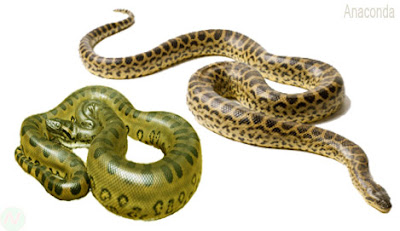
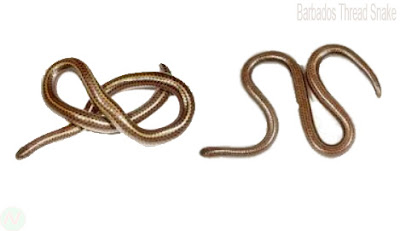
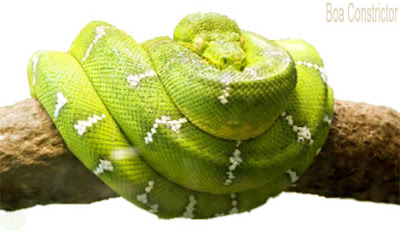

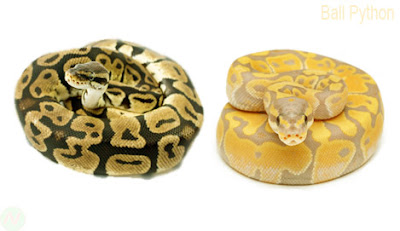
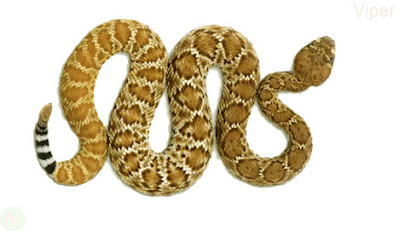

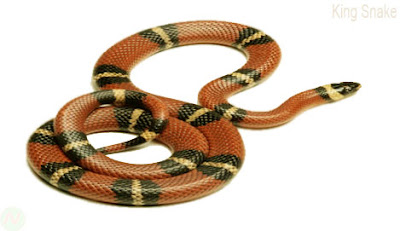
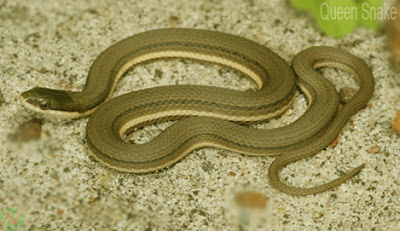
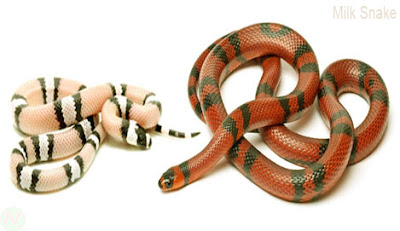






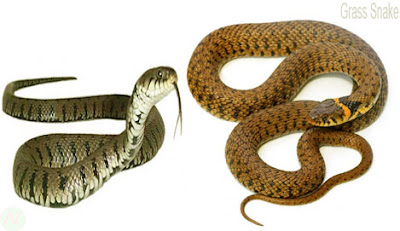



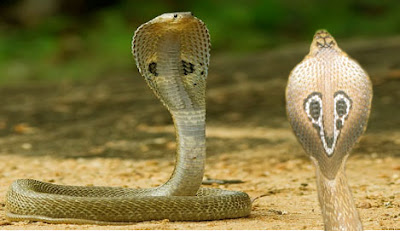
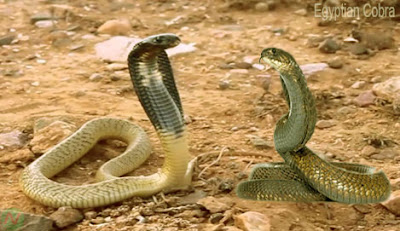

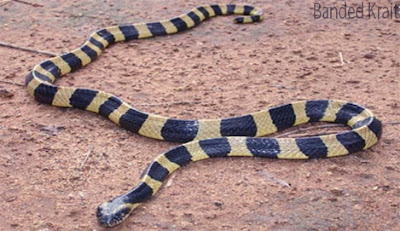

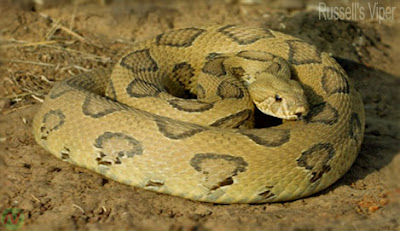
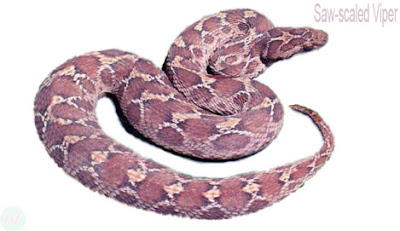




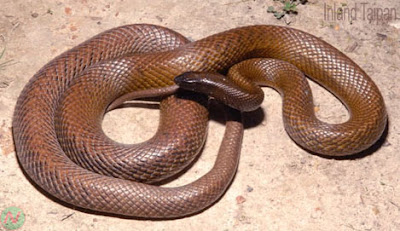
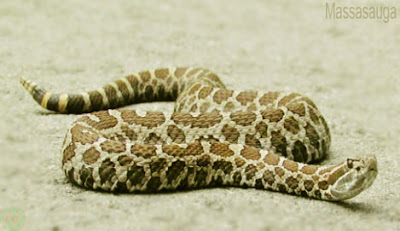

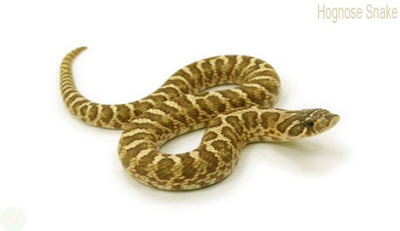
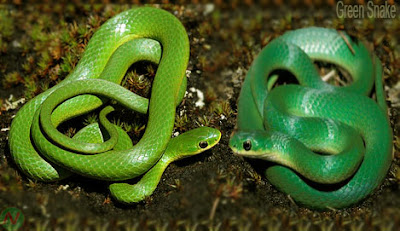
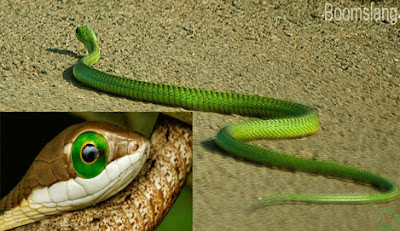
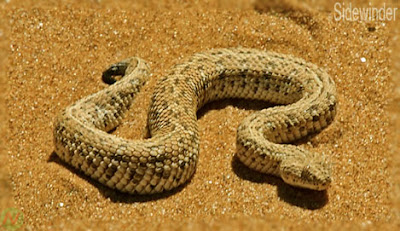
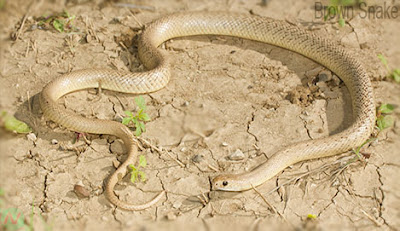

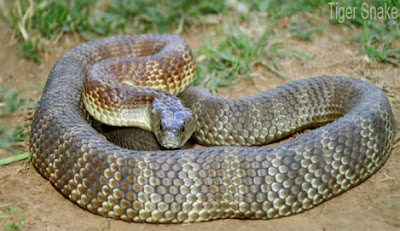

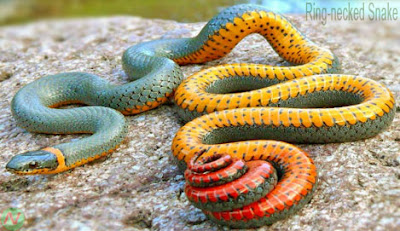

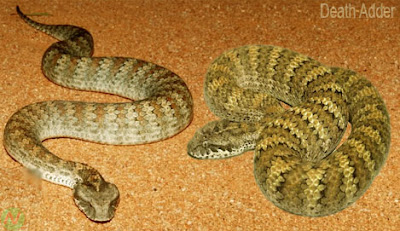
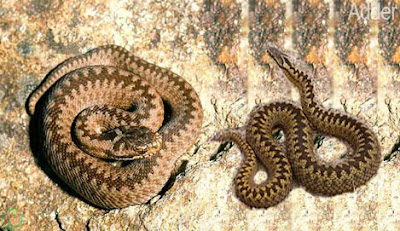










No comments